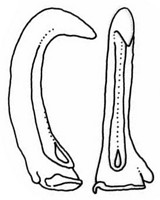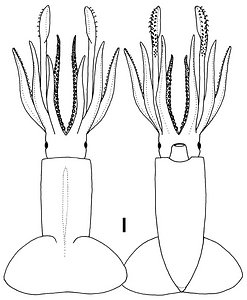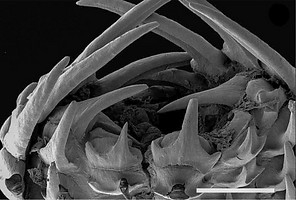Walvisteuthis rancureli
K.S.R. Bolstad and Richard E. YoungIntroduction
Walvisteuthis rancureli is a small squid; the maximum adult size recorded is a female of 150 mm ML (Bolstad, 2010).
Brief diagnosis:
A Walvisteuthis with ...
- robust, strongly recurved club hooks, with curved necks.
- longest club hooks ~15% club length.
- up to 5 marginal club suckers in combined dorsal and ventral series.
Characteristics
- Arms
- Arm formula II> or = III=IV>I. Arms II-IV 86% of ML. Arms with 70-90 large suckers at >45 mm ML
- Arm formula II> or = III=IV>I. Arms II-IV 86% of ML. Arms with 70-90 large suckers at >45 mm ML
- Tentacles
- Tentacles robust; clubs ~38% ML (range: 33-48% ML. Carpus with 7-10 suckers. Manus with 24-27 hooks. Up to 5 marginal suckers present at 105 mm ML. Terminal pad with 8-11 suckers.
- Hooks robust, strongly curved in profile, with curved necks.Longest ventral hook (V5 or V6) ~3x length of dorsal counterpart and ~15% of club length at 105 mm ML or ~10% of club length at 35 mm ML. Ventral hook bases approximately symmetrical.
 Click on an image to view larger version & data in a new window
Click on an image to view larger version & data in a new window
Figure. Oral view of the tentacular club of W. rancureli, female, 105 mm ML. Drawing from Bolstad (2010).
 Click on an image to view larger version & data in a new window
Click on an image to view larger version & data in a new window

Figure. A large hook (V5) from the ventral hook series of the club of W. rancureli, female, 105 mm ML. Drawings - Slightly oblique profile view (left) and an oral view (right). Photograph - Scanning electron micrograph. All three images from Bolstad (2010).
- Tentacles robust; clubs ~38% ML (range: 33-48% ML. Carpus with 7-10 suckers. Manus with 24-27 hooks. Up to 5 marginal suckers present at 105 mm ML. Terminal pad with 8-11 suckers.
- Head
- Head length ~20% of ML (range 16-25%), width ~ 25% ML.
- Radula: Rachidian tricuspid; 1st lateral tooth bicuspid, ~60% of rachidian height; 2nd lateral tooth unicuspid, ~125% of rachidian height; marginal tooth ~200% of rachidian height.
- Head length ~20% of ML (range 16-25%), width ~ 25% ML.
- Fins
- Broadly ovate; length ~42%of ML (range: 32-49% ML); width ~93" of ML (range: 70-100% ML).
- Photophores
- Photophores absent.
- Gladius
- Gladius visible dorsally through integument. Rostrum ventrally through posterior ~3% of ML.
Comments
The above description W. rancureli is taken from Bolstad (2010) which contains more details than presented here.
References
Bolstad, K. 2010. Systematics of the Onychoteuthidae Gray, 1847 (Cephalopoda: Oegopsida). Zootaxa 2696: 1–186.
Title Illustrations

| Scientific Name | Callimachus rancureli |
|---|---|
| Copyright |
© K.S.R. Bolstad

|
About This Page
K.S.R. Bolstad

Auckland University of Technology

University of Hawaii, Honolulu, HI, USA
Page copyright © 2015 K.S.R. Bolstad and
All Rights Reserved.
- First online 26 February 2015
- Content changed 11 October 2015
Citing this page:
Bolstad, K.S.R. and Richard E. Young. 2015. Walvisteuthis rancureli . Version 11 October 2015 (under construction). http://tolweb.org/Walvisteuthis_rancureli/145222/2015.10.11 in The Tree of Life Web Project, http://tolweb.org/









 Go to quick links
Go to quick search
Go to navigation for this section of the ToL site
Go to detailed links for the ToL site
Go to quick links
Go to quick search
Go to navigation for this section of the ToL site
Go to detailed links for the ToL site